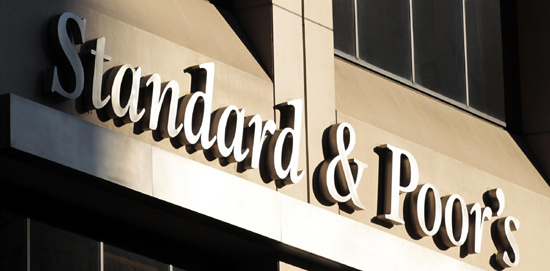US loses AAA credit rating from S&P
Updated: 2011-08-06 10:56
(Agencies)
|
|||||||||||
|
 Standard and Poor's building in New York, in this August 2, 2011 file photo. The United States lost its top-notch AAA credit rating from Standard & Poor's on August 5, in an unprecedented reversal of fortune for the world's largest economy. Picture taken August 2, 2011. [Photo/Agencies] |
NEW YORK - The United States lost its top-notch AAA credit rating from Standard & Poor's on Friday in an unprecedented reversal of fortune for the world's largest economy.
S&P cut the long-term US credit rating by one notch to AA-plus on concerns about the government's budget deficits and rising debt burden. The move is likely to raise borrowing costs eventually for the American government, companies and consumers.
"The downgrade reflects our opinion that the fiscal consolidation plan that Congress and the Administration recently agreed to falls short of what, in our view, would be necessary to stabilize the government's medium-term debt dynamics," S&P said in a statement.
The decision follows a fierce political battle in Congress over cutting spending and raising taxes to reduce the government's debt burden and allow its statutory borrowing limit to be raised.
On Aug. 2, President Barack Obama signed legislation designed to reduce the fiscal deficit by $2.1 trillion over 10 years. But that was well short of the $4 trillion in savings S&P had called for as a good "down payment" on fixing America's finances.
The White House maintained silence in the immediate aftermath of S&P downgrade.
The political gridlock in Washington and the failure to seriously address US long-term fiscal problems came against the backdrop of slowing US economic growth and led to the worst week in the US stock market in two years.
The S&P 500 stock index fell 10.8 percent in the past 10 trading days on concerns that the US economy may head into another recession and because the European debt crisis has been growing worse as it spreads to Italy.
US Treasury bonds, once undisputedly seen as the safest security in the world, are now rated lower than bonds issued by countries such as Britain, Germany, France or Canada.
'Daunting' Implications
As the focus for investors shifted from the debate in Washington to the outlook for the global economy, even with the prospect of a downgrade, 30-year long bonds had their best week since December 2008 during the depth of the financial crisis.
Yields on 10-year notes, a benchmark for borrowing rates throughout the economy fell as far as 2.34 percent on Friday -- their lowest since October 2010 -- also very low by historical standards.
"To some extent, I would expect when Tokyo opens on Sunday, that we will see an initial knee-jerk sell-off (in Treasuries) followed by a rally," said Ian Lyngen, senior government bond strategist at CRT Capital Group in Stamford, Connecticut.
The outlook on the new US credit rating is "negative," S&P said in a statement, a sign that another downgrade is possible in the next 12 to 18 months.
"The long-term implications are daunting. Short-term, Treasuries remain a premier safe-haven refuge," said Jack Ablin, chief investment officer at Harris Private Bank in Chicago.
Borrowing Costs Could Rise
The impact of S&P's move was tempered by a decision from Moody's Investors Service earlier this week that confirmed, for now, the US Aaa rating. Fitch Ratings said it is still reviewing the rating and will issue its opinion by the end of the month.
"It's not entirely unexpected. I believe it has already been partly priced into the dollar. We expect some further pressure on the US dollar, but a sharp sell-off is in our view unlikely," said Vassili Serebriakov, currency strategist at Wells Fargo in New York.
"One of the reasons we don't really think foreign investors will start selling US Treasuries aggressively is because there are still few alternatives to the US Treasury market in terms of depth and liquidity," Serebriakov added.
S&P's move is also likely to concern foreign creditors especially China, which holds more than $1 trillion of US debt. Beijing has repeatedly urged Washington to protect its US dollar investments by addressing its budget problem.
Obama administration officials grew increasingly frustrated with the rating agency through the debt limit debate and have accused S&P of changing the goal posts in its downgrade warnings, sources familiar with talks between the administration and the ratings firm have said.
The downgrade could add up to 0.7 of a percentage point to US Treasuries' yields over time, increasing funding costs for public debt by some $100 billion, according to SIFMA, a US securities industry trade group.
S&P had placed the US credit rating on review for a possible downgrade on July 14 on concerns that Congress was not adequately addressing the government fiscal deficit of about $1.4 trillion this year, or about 9.0 percent of gross domestic product, one of the highest since World War II.
The unprecedented downgrade of the nation's AAA credit rating by a major ratings agency comes only 15 months before the next presidential election where the downgrade and the debt will be top issues for debate.
Bitter political battles remain over the ideologically fraught issues of spending cuts and tax reform.
The compromise reached by Republicans and Democrats this week calls for the creation of a bipartisan congressional committee to find $1.5 trillion of deficit cuts by late November, beyond the $917 billion already identified.